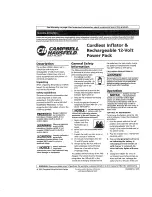
7
6.0
Electrical connections
Electrical connections must be
made by a qualified electrician in compliance
with all relevant codes. This machine must be
properly grounded to help prevent electrical
shock and possible fatal injury.
The EMN-9 Electric Notcher is pre-wired for 230-
volt, three-phase operation. It is not provided with a
power plug; you may either attach a proper 230V, 3-
phase UL-listed plug, or “hardwire” the machine
directly to a service panel (make sure a disconnect
is available to the operator).
It is recommended that the Electric Notcher be
connected to a dedicated 15 amp circuit with a
circuit breaker or fuse. If connected to a circuit
protected by fuses, use time delay fuse marked “D”.
NOTE:
Local codes take precedence over
recommendations.
6.1
GROUNDING INSTRUCTIONS
This tool must be grounded. In the event of a
malfunction or breakdown, grounding provides a
path of least resistance for electric current to reduce
the risk of electric shock.
If used with a plug:
Grounded, cord-connected tools intended for use on
a supply circuit having a nominal rating between
150-250 V inclusive:
This tool is intended for use on a three-phase circuit.
Make sure the tool is connected to an outlet having
the same configuration as the plug. No adapter is
available or should be used with this tool. If the tool
must be reconnected for use on a different type of
electric circuit, the reconnection should be made by
qualified service personnel; and after reconnection,
the tool should comply with all local codes and
ordinances.
If hardwired:
Permanently connected tools: This tool should be
connected to a grounded metal permanent wiring
system; or to a system having an equipment-
grounding conductor.
Improper connection of the
equipment-grounding conductor can result in a
risk of electric shock. Check with a qualified
electrician or service person if you are in doubt
as to whether the outlet is properly grounded.
The conductor with insulation having an outer
surface that is green with or without yellow stripes is
the equipment-grounding conductor. If repair or
replacement of the electric cord or plug is
necessary, do not connect the equipment-grounding
conductor to a live terminal.
Repair or replace damaged or worn cord
immediately.
6.2
Extension cords
The use of extension cords is discouraged; try to
position equipment within reach of the power
source. If an extension cord becomes necessary, be
sure it is heavy enough to carry the current your
product will draw. An undersized cord will cause a
drop in line voltage resulting in loss of power and
overheating.
Table 1 shows recommended size to use depending
on cord length and nameplate ampere rating. If in
doubt, use the next heavier gauge. The smaller the
gauge number, the heavier the cord.
Ampere
Rating
Volts
Total length of
cord in feet
More
Than
Not
More
Than
240 50 100 200 300
AWG
0
0
0
6 18
16 16 14
0
6 10 18
16 14 12
10 12 16
16 14 12
12 16 14
12
Not
Recommended
Extension Cord Recommendations
Table 1


































